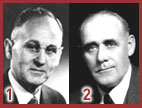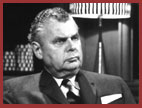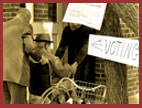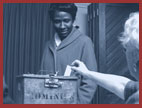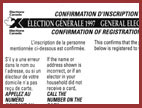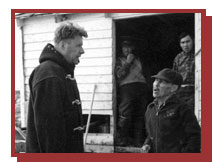 |
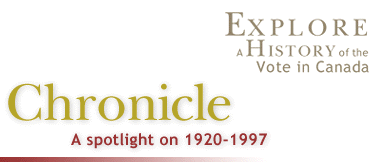
|
A lengthy debate "We are all united" The right to vote for all Aborignal people No special act electoral process Consolidation and review, 1961-1982 Advance voting Voter notification Opening up the process |

"Indians" in most parts of Canada had the right to vote from Confederation on – but only if they gave up their treaty rights and Indian status through a process defined in the Indian Act and known as ‘enfranchisement’. Quite understandably, very few were willing to do this. Métis people were not excluded from voting; few were covered by treaties, so there were no special rights or other basis on which to justify disqualifying them. Inuit were not excluded either, but no steps were taken to include them. Most were geographically isolated well into the twentieth century, so in the absence of special efforts to enable them to vote, they had no means to exercise the franchise.
Aboriginal peoples had formed social groupings and elaborated systems of government well before their first contacts with Europeans. Many therefore looked unfavourably on nineteenth-century proposals for enfranchisement for at least two reasons: first, it would mean an end to their recognition as distinct nations or peoples – as signified by their treaties with France, Great Britain and later Canada – and the beginning of assimilation into non-Aboriginal society.
Second, voting in Canadian elections would mean participating in a system of government that was quite alien to the traditions, conventions and practices of governance of many Aboriginal peoples. Further, electoral participation would have been essentially redundant – they already had their own systems for choosing leaders and governing themselves.
In short, Aboriginal people were unenthusiastic about having the right to vote if it meant giving up their individual and group identity. Thus, until the government of Canada extended the vote to Indian persons unconditionally in 1960, there is little evidence that Aboriginal people wanted it or sought it.
Proposals from non-Aboriginal politicians to extend the franchise date at least to 1885, although they met a great deal of hostility. Isaac Burpee, MP for Saint John, said that the Indian knew no more of politics "than a child two years old", while A.H. Gillmor, the member for Charlotte, called the proposal to give Indians the vote "the crowning act of political rascality" on the part of Sir John A. Macdonald. One reason for this opposition, apart from prevailing paternalistic or racist social attitudes, was the notion that Aboriginal people would become the dupes of non-Aboriginal politicians. Both Canada and the United States have a long tradition of newly-enfranchised voters voting en bloc, often as directed by their community leaders. As these voters gained more education and became more integrated into North American society, they tended to drift away from the influence of political ‘bosses’.
For almost a century after the 1885 debate, there was little pressure to extend the franchise to Aboriginal citizens, though it was extended in 1924 to Aboriginal veterans of the First World War, including veterans living on Indian reserves.
"We are all united" A great many Aboriginal people served with distinction in the Canadian forces during the Second World War, and this was among the reasons leading many Canadians to conclude that the time had come for all Aboriginal people to have the full rights of citizenship. A parliamentary committee recommended in 1948 that they be given the vote. The chairman of the Indian affairs committee said
The government did extend the franchise to Inuit – who did not have treaties or reserves and so were considered ‘ordinary citizens’ already – but Indian people who wanted the vote would still have to waive their right to tax exemptions. Not surprisingly, given the significance of this treaty right, few did so. The right to vote for all Aboriginal peoples It was not until John Diefenbaker became prime minister that the franchise was extended with no strings attached. Mr. Diefenbaker had long advocated extending the vote to Aboriginal people. In his memoirs, he described how he had met many Indians as a child and had committed himself to getting them the right to vote. (One Canada, I, 29-30)
On 10 March 1960, after a debate marked by virtually unanimous support, the House of Commons finally gave Aboriginal people the vote without making them give up treaty rights in exchange. Mr. Diefenbaker then appointed James Gladstone to the Senate, where he was the first member of Aboriginal origin. In 1968, the first Aboriginal person elected to the House of Commons was Len Marchand, representing the B.C. constituency of Cariboo. More Aboriginal people have been elected since then, though by no means in proportion to their presence in the Canadian population.
No special act
In each of the instances just recounted – extension of the vote to Canadians of Japanese and Chinese origin, to the Doukhobors, and to Aboriginal people – change was accomplished by amending the existing electoral law. Such advances in the franchise might have been trumpeted as great achievements in human and democratic rights. For instance, J.W. Pickersgill, minister of citizenship and immigration in the previous Liberal government, suggested adoption of a special act to solemnize the 1960 enfranchisement of on-reserve Indians. But Ellen Fairclough, Canada’s first female cabinet member, who was charged with seeing the amendments through the house, said that this would be "merely gilding the lily". (Debates, 10 March 1960, 1957)
Mechanisms to ensure that eligible voters could exercise their franchise multiplied in this period. In 1948, for example, time off to vote was increased to three hours. This rose to four hours in 1970, before settling back at three hours in 1996, when polling hours were extended, making the extra time off unnecessary. A greater departure in voting procedures was the postal ballot for members of the armed forces. The Mackenzie King government instituted the system for military personnel serving overseas during the Second World War, allowing some 342,000 members of the armed forces to vote in the 1945 general election. For the same election, proxy voting was introduced for Canadians being held as prisoners of war. Proxy votes (some 1,300 in 1945) were cast by the nearest relatives of those being held prisoner. The provision was restored in 1951 and used again during the Korean conflict, when 18 Canadians were prisoners of war. Voting by people who were away from home on election day was accommodated by several innovations in this period. In 1951, special arrangements were introduced in sanatoriums and chronic care hospitals. Voting at polling stations set up in these locations (and in homes for the elderly after 1960) would be suspended temporarily so that election officials (with permission from those in charge of the facility) could take the voting equipment from room to room, enabling anyone who was bedridden to vote if they wished to do so.
In addition, the military postal ballot was extended to the spouses of armed forces personnel in 1955, so that they could vote while accompanying their husbands or wives on a posting away from the home constituency.
Consolidation and Review, 1961-1982 By 1960, then, amendments to Canada’s electoral law had resulted in significant advances over the situation in 1920: racial and religious discrimination was no longer a factor in voter qualifications, and no major group was deprived of the franchise deliberately or directly. The most significant changes in the law were concerned mainly with refining the electoral system – changes that affected how the system worked, rather than the extent or nature of the franchise. Among these modifications were recognition of political parties in the law and the appointment of impartial commissions to set new constituency boundaries to reflect demographic change. Both changes had significant effects on the electoral process; but from an elector’s perspective, the most discernible result was probably the appearance of candidates’ party affiliations on the ballot and the opportunity to make a tax-deductible contribution to a political party.
This period also saw numerous changes affecting individual voters, including extension of advance voting provisions to all voters, adjustments to voters lists, and reduction of the voting age to 18. In addition, this was a period when the rights and concerns of people with disabilities began to gain greater public recognition, resulting in changes in their access to the polls and privacy in casting their ballots. Finally, the passage of official languages legislation meant that voters everywhere would have access to election materials in both official languages.
Advance voting When first introduced in 1920, voting at advance polls had been limited to only a few classes of voters. Advance voting was extended to members of the RCMP and the armed forces in 1934 and to members of the military reserves in 1951. In each case, a voter at an advance poll had to swear on oath that he or she would be away on business on election day. The election of 1953 was held in August, when many potential voters were on vacation. Turnout was only 68 per cent, compared with 75 per cent in the June 1949 election and 75 per cent in the June 1957 election. The Progressive Conservatives felt that they had been especially hard-hit by this1. After the Conservatives gained power at the 1957 election, the advance vote was extended to all electors who had reason to believe they would be absent from their polling division on election day and therefore unable to vote. Electors still had to swear an affidavit, however, under this 1960 amendment to the act. At the next general election – in 1962 – voter response was remarkable. The number of advance votes rose from an average of 10,000 in previous elections to nearly 100,000 and has risen steadily ever since.
In 1977, the requirement to swear an affidavit was dropped. At the same time, a provision was introduced allowing people to vote at the returning officer’s office during the electoral period if they could not vote at an advance poll or on election day. This provision was dropped in 1993, when the special ballot rendered it unnecessary.
As we have seen, the 1934 provision requiring that a postcard be sent to each registered elector proved too expensive. Instead, voters were sent a copy of the voters list for their poll. This system continued for several decades, but by the 1970s many voters were objecting to what they considered an unacceptable invasion of privacy – in particular, women living alone and people who thought their occupation or the identity of the members of their households was no one’s business but their own. There were also concerns that the lists – which together contained the names, addresses, and occupations of the adults in every household in the country – could be used for other than electoral purposes.
In 1982 this provision was therefore dropped from the act. Instead, in a move reminiscent of 1934, each registered elector would receive a postcard confirming registration and showing where to vote; technological change had made this approach much more feasible and affordable than it had been in 1934. Electors who did not receive a card would know that they had to take steps to register if they wanted to vote.
Opening up the process In the largest expansion of the vote since women were enfranchised in 1918, people between the ages of 18 and 20 got the vote in 1970 and used it for the first time in the 1972 election. Although reducing the voting age to 18 expanded the electorate considerably – by some two million young people in all – this change was not quite like removing religious or racial discrimination from the electoral law. After all, nearly everyone who gained the franchise in 1970 would have done so within a few years anyway, simply by growing older; a significant number of them would have been able to vote in 1972 even if the voting age had not been lowered. The same could not be said of citizens excluded from the vote on racial or religious grounds. Also, unlike extension of the franchise to racial and religious minorities, lowering the voting age aroused relatively little controversy. It was the ’70s, the youth culture was at its height, and a general opening up of social and political life had begun as the politics of participation took hold.
This same social climate gave rise to greater recognition of the rights of voters with disabilities and others who might be excluded from voting for reasons related to physical abilities or illness. This recognition produced some legislative change, but for the most part voters’ special needs were addressed through administrative measures that were later incorporated in the law. Thus, for example, a 1977 amendment to the law introduced transfer certificates, allowing electors to vote at an advance poll with level access if their own was inaccessible. At the same time, throughout the 1970s, polling stations were located increasingly in public buildings, so that level access became more widely available. Special templates were also devised so that voters who were blind or visually impaired could preserve the secrecy of the vote, casting their ballots without assistance. These administrative arrangements became part of the law in 1992.
Voting by proxy and voting outside Canada Proxy voting was extended twice in this period – to fishermen, sailors and prospectors in 1970, along with people who were ill or had physical disabilities, and to airplane crews, forestry and mapping teams, and trappers in 1977. (In 1993, proxy voting was repealed when the special mail-in ballot made it redundant.) A third set of changes opened the vote to certain classes of electors living abroad. Public servants (mainly diplomats) and their dependants posted outside Canada became eligible to use the special voting rules – previously available only to military personnel and their dependants – in 1970, as did civilian employees of the military (usually teachers and administrative support staff at schools on Canadian forces bases) in 1977. But ordinary Canadians who happened to be away from home in an election period still could not vote. A final set of administrative changes related to the Official Languages Act, which applied to constituencies where at least 5 per cent of the population spoke the minority official language. There were 92 such electoral districts across the country.
One slight narrowing of the franchise occurred in this period. In 1970, the law was amended to provide that British subjects who had not adopted Canadian citizenship would be disqualified from voting unless they took out citizenship by 1975. Before then, British subjects were qualified electors, but they had to be "ordinarily resident in Canada".
|
 |
